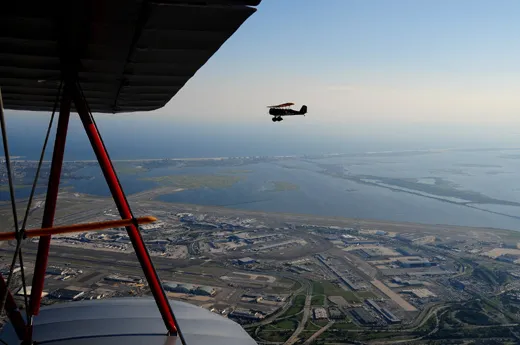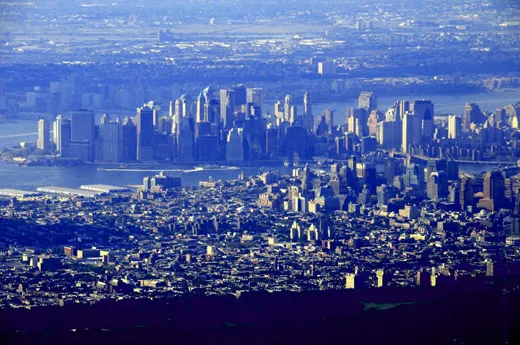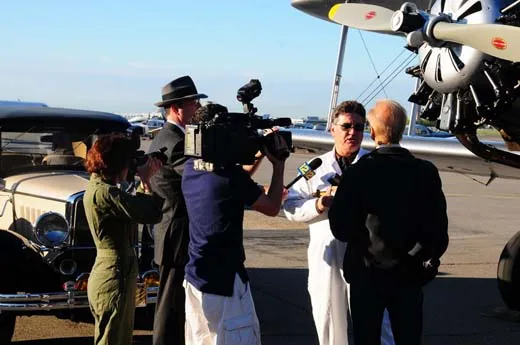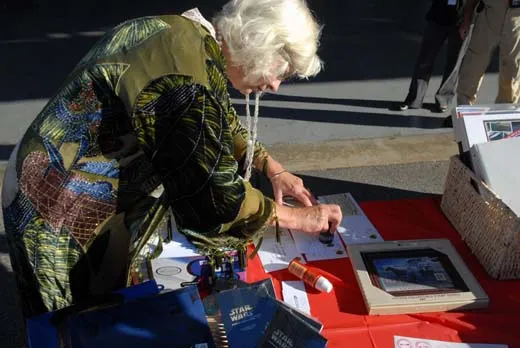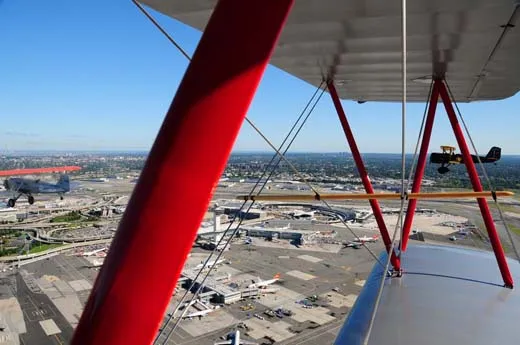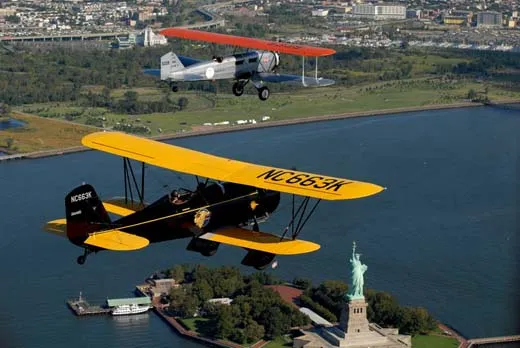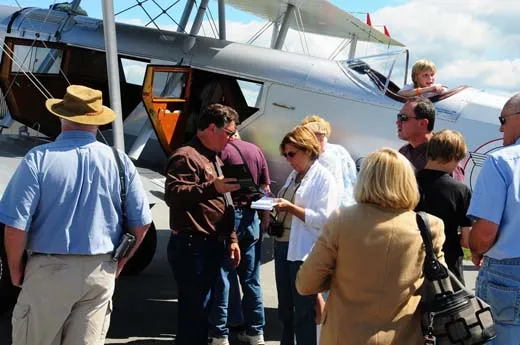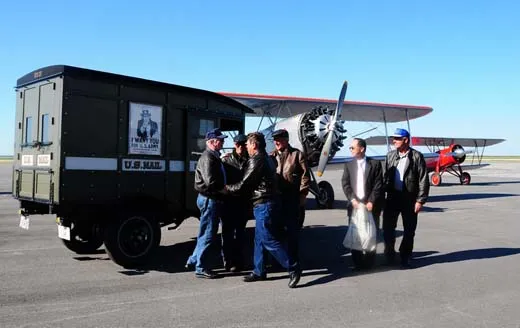A Ride in the Boeing 40C
Onboard “Airmail 1” for the first leg of the trip, from New York to Bellefonte.
/https://tf-cmsv2-smithsonianmag-media.s3.amazonaws.com/filer/40c-main.jpg)
“Do you have an airsickness bag and some Dramamine?” asks Addison Pemberton, pilot of the Boeing 40C. It’s Tuesday night, and I’ve traveled by subway, train, and automobile to Republic Airport on Long Island for the privilege of flying with Pemberton and four others as they retrace the airmail route from New York to San Francisco.
“Eat bananas,” advises Ben Scott, who pilots the 1930 Stearman Speedmail. As I scrawl Find grocery store. Bananas, Ben continues, “They taste the same coming up as they do going down.”
I draw a line through my to-do note.
I’m already somewhat nervous about flying the New York-to-Bellefonte leg. As Donald Dale Jackson reported in a 1991 Air & Space article, "The long, low ridges that roll across central Pennsylvania like waves on a choppy sea—hard to read from the air, prey to violent weather changes, and short on flat clearings for forced landings—were dreaded by pioneer fliers. Those who endured the area called it the ‘Hell Stretch.’ ”
But the five men re-creating the trip are all experienced pilots, and my fears soon disappear. Pemberton, who coordinated the reenactment, and Scott are joined by Larry Tobin, pilot of a 1927 Stearman C3B; Al Holloway, pilot and mechanic extraordinaire; and George Perks, a pilot and the photographer who is supplying the photo blog for the trip.
At dinner, the men eat heartily, and talk about various airmail pilots and the difficulties they faced. They regale me with past adventures and their hopes about the reenactment. I hear the refrain “We’re living the dream” several times. As the evening winds down, we agree to meet in the hotel lobby at 6:00 a.m. the next morning.
At the appointed hour I head downstairs. The entire crew is already waiting in the lobby. We make the short drive to the American Airpower Museum, where the vintage aircraft were stored overnight.
Many of the American Air Power Museum employees and volunteers have shown up in period clothing, as have representatives of the United States Postal Service. We’ll be carrying about 700 letters on our flight, which will be stamped at each stop (some of these will go on sale). We were supposed to be on the television news at 6:30, but were preempted by a breaking story about a serial killer. The television cameras show up a bit later though, and Addison gives an eloquent speech about airmail history.
Jim Vocell, vice president of museum operations at the American Airpower Museum, worries that I’ll be cold during the trip, and offers me a flightsuit. But I decide to experience the flight as a 1928 passenger would (although I know a 1920s airline passenger would be scandalized by my T-shirt and jeans).
Then it’s time. To enter the 40C, I stand on Addison’s back, who is on his hands and knees. I feel bad about crushing the pilot before we even begin our flight, but Addison assures me that everyone enters and exits the Boeing in this manner.
The 40C is a beautiful aircraft; only 10 were built. They were designed for use as mail carriers; only later were they converted to carry passengers. The extremely comfortable mahogany-accented cabin seats four. The engine sits in front of the passenger cabin, so there's no forward view, but I have great visibility to the right and left. The windows look out over the airplane’s 44-foot wingspan.
Our call sign for the trip is “Airmail 1.” Ben and Larry are “Airmail 2” and “Airmail 3,” respectively.
We plan to head straight for the Statue of Liberty and make a pass before heading for Bellefonte. But at the request of the air traffic controllers at JFK, we make a slow pass by the control tower. “You’re looking beautiful, Airmail 1,” says the tower as we depart.
We fly over Floyd Bennett Field (New York City’s first municipal airport) at 700 feet, and Addison requests permission to circle the Statue of Liberty. We make one pass of the Statue of Liberty at 1,200 feet, ever mindful of Larry’s limited fuel capacity. (The Stearman C3B carries only 50 gallons of fuel, and making it to Bellefonte will be close as it is.)
JFK hands us off to LaGuardia air traffic control, which asks, “Airmail 1, what are you?” Addison gives the controller a quick description, and soon we’re away from the city.
I’m trying to follow the 1921 Pilots' Directions, but it's difficult. I don't know if I've correctly identified the Orange Mountains, or Hopatcong and Budd lakes. The first landmark I'm absolutely certain of is at mile 78: "The Delaware makes a pronounced U-shape bend just north of Belvidere. A railway joins the two ends of the U.” To our right is a mountain range. Larry says, “I bet Jack Knight [an early airmail pilot] ran the gap on our right.” The notch is so close to the treeline, reminding me again how low the airmail pilots flew.
The cockpit is open, and behind the passenger cabin. As we fly, Addison speaks with me by radio. “Jack Knight may have seen that same church steeple,” he muses. “In my 39 years of flying,” he continues, “this is some of the best weather I’ve ever seen. The plane is running fantastic. It’s purring like a cat in a creamery.”
The 40C’s windows slide open, and I poke my head out the window, snapping pictures and shooting video; this is the way to travel!
While I’m busy being a tourist, Addison shares some history with me. “When an airmail pilot got into the cockpit and began setting up with his directions and everything else, it was called ‘building the nest.’ ” From our earlier conversations, I know that Addison has “built his nest,” in part, with boxes of Good & Plenty. (His love of sweets has earned him the trip nickname of “Sugar Bear.”)
“We’re going to do a Tora Tora Tora pass,” says Addison as we approach Bellefonte. “How’s your stomach?”
My stomach is great, but as we fly in formation over Bellefonte, I hear Larry on the radio. “Sugar Bear, does Rebecca know her door is open?” I glance over and sure enough, the latch has come unhooked. I scramble to close the door while the three airplanes fly in formation over the airfield. Larry lands first, taxiing up to the fuel pump, while Addison and Ben make a dramatic pass over the airport. We land—after a two-hour, 45-minute flight—to a cheering crowd.
“It was good to hear them in the air, wasn’t it?” I hear one man say to his friend. When Addison asks for help in pushing the 40C into position, volunteers jump to assist.
“If the airplane gets away from you, throw your bodies in front of the Boeing,” Addison jokes. “Remember: People heal, airplanes don’t.”
There’s a lovely ceremony and the crew takes a well-deserved break before heading off for the next stop, Cleveland.
Next May, the men plan to re-create the 40C’s historic route, and they’re already making tentative plans to celebrate airmail’s 100th anniversary—although perhaps not in these particular airplanes. “I don’t know if I’ll still be able to wrassle that old girl,” Larry says of his 1927 Stearman.
Whatever they’re flying, I’m hoping to be along for the ride.
